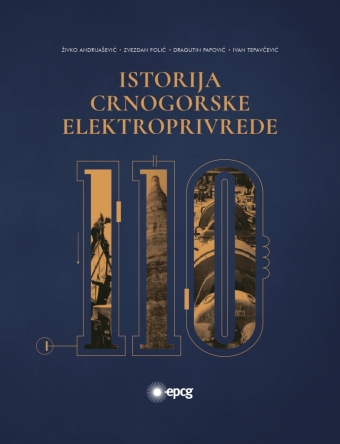We published our history in monography "100 years of EPCG".
Electrification of Montenegro started in the first decade of the 20th century. Almost a century long tradition began only 28 years after construction of the first world power station which was founded in New York by famous American inventor Thomas Edison. Thus Montenegro became one of the rare European and world countries of the time whose towns had electricity.
Electrification began on August 19th, 1910 in Cetinje when the first power plant in Montenegro was put into operation on the occasion of crowning of Nikola I Petrovic. Under the current conditions, this would be a small hydro power plant with two diesel engines of 110 kW. Over the years, its capacity was doubly increased to 220 kV. Electricity generated by the power plant was used for lighting of the Residence, Zetski dom, main streets of the town and several houses of the distinguished Montenegrins. It became basis of development of one of the most important business entities in Montenegro, Elektroprivreda Crne Gore. The power plant was in operation for 50 years, 450,000 hours of continuous operation - 12 years without any failure. The power plant was constructed and equipped by reputable company of the time owned by Emanuel Kraus from Trieste. Building and installations of „Electricity Company of Montenegro“, which was the first name of the power plant in Cetinje, were preserved and protected by the Law as a cultural heritage due to their significant importance. On November 13th, 1976, they were transformed into the museum of EPCG, with the proposal of becoming the Technical Museum of Montenegro. The day of putting the first power plant into operation, August 19th, is celebrated as the Day of EPCG AD Niksic.
Soon after putting into operation the small power plant in Cetinje, other power plants in Montenegro started to be constructed; thus enabling other towns and citizens of Montenegro to enjoy benefits of electricity: Bar in 1913., Kotor in 1916, Herceg Novi in 1925, Podgorica and Nikšić in 1927, Risan in 1928, Kolašin in 1929, Ulcinj in 1930, Zelenika in 1935, Perast in 1936, Pljevlja in 1937, Tivat in 1939 and so on.
The first phase of development of the energy system of Montenegro was completed by construction of the so called small or distributive power plants when the second phase of development started. In the year 1937, HPP „Podgor“ with the capacity of 250 kW was constructed near Cetinje, which still generates electricity. After the mentioned power plant, the following ones were constructed: "Rijeka Musovica" in 1950, with the capacity of 1.36 MW (1360 kW), "Slap Zete" in 1952, with the capacity of 1.2 MW and annual generation of 6000 GWh, "Rijeka Crnojevica", also in 1952, with the capacity of 754 kW (only 160 kW during commissioning) and "Glava Zete" in 1955, with the capacity of 4.5 MW which is the only one being underground. The following two small hydro power plants are also currently in operation: "Lijeva Rijeka" and "Savnik"; the total capacity of small hydro power plants amounts to 8.5 MW.
The third phase of development began with construction of big hydro power plant, HPP "Perucica", which was commissioned in 1960 in the first stage of its construction. After finalisation of the second and third stage of construction of this hydro power plant, Montenegro had significant electricity surpluses. Sixteen years later, another big hydro power plant was constructed - "Piva", with the highest dam in the Balkans, i.e. one of highest in Europe (220 m); in 1982, TPP "Pljevlja" was constructed. This was the last constructed generating unit of Elektroprivreda Crne Gore.
In addition to generating units, Elektroprivreda Crne Gore owns considerable electricity network of different voltage levels with overhead lines, substations and other facilities, as well as dispersed distribution network reaching all inhabited areas of Montenegro. Development of distribution and transmission network was accompanied by development and improvement of generating units.
This was a brief history of EPCG describing the manner we were keeping up with the world achievements, thus providing a strong basis for even more quality development.
You can download monography here.
-
11.12.23
Public Invitation for EPCG-Željezara Nikšić

-
26.07.23
DJUKANOVIC: PERSPECTIVES ON ELECTRICITY GENERATED BY SOLAR POWER PLANTS AS PART OF SOLARI 3000+ AND 500+ PROJECT

-
28.10.22
XXV EXTRAORDINARY EPCG SHAREHOLDERS’ MEETING TOOK PLACE

-
28.10.22
FROM THE PROFESSIONAL POINT OF VIEW: EPCG IN THE CONTEXT OF THE GLOBAL ENERGY CRISIS

- Home
- About us
- Core activity
- History

